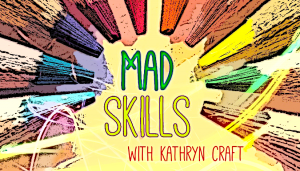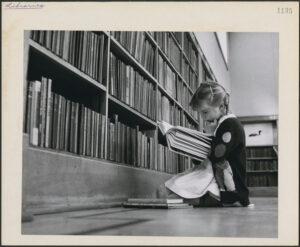Author in Progress
Therese here to introduce our newest regular contributor for Writer Unboxed, author Harper Ross! Harper’s debut novel of magical realism, The Unwritten Rules of Magic, will release on 2/25/26. We’re thrilled to have her with us. Welcome, Harper!
I wrote my first manuscript in secret. No one knew—not my husband, my kids, or even the dog. Well, okay, our dog might have suspected. I snuck in writing time whenever everyone else was occupied, relishing the freedom of creating something without the weight of anyone’s expectations, opinions, or questions. It was a magical experience, yet not one I would recommend. Why? Well, let’s just say that my fledgling novel holds far more sentimental value than commercial appeal.
It wasn’t until my third manuscript that I finally landed my agent. Those in-between years were my crash course in what it takes to go from dreaming about publishing to doing it. I dove into craft books, attended workshops, and wrestled with my personal demons, like self-doubt and perfectionist tendencies. (How many times can you rewrite a first chapter? Spoiler: far too many.)
But if I had to credit one thing that got me to the finish line, it would be finding my people.
Why a Writing Community Matters
As writers, we spend an inordinate amount of time alone with our imaginary friends. It can become slightly claustrophobic to live in your head, retreading your same “thought ruts,” as I call them. A circle of writer friends is a lifeline to the outside world. They also provide a creative brain trust. Unlike a lone wolf, a team can cover all the angles: brainstorming ideas, giving honest feedback, sharing industry know-how, and, most importantly, offering moral support when the writing life inevitably gets messy.
Of course, many writers are introverts, which makes the idea of “putting yourself out there” as appealing as signing up for an insurance industry networking event. Add in a rural setting or a lack of MFA connections, and it’s easy to feel like building a community is impossible.
But don’t worry—I’ve done the legwork and am happy to share my experiences.
Places to Find Your People
Writer Unboxed
Let’s start with the obvious: if you’re reading this, you’re already halfway there. Writer Unboxed has been a constant source of craft advice, writerly encouragement, and solidarity in the face of self-doubt. While online communities serve an important function, nothing beats personal contacts. If you ever get the chance to attend one of its in-person conferences, go. Seriously. There’s something thrilling about meeting your “virtual friends” in real life. The only thing that might be more delightful would be bringing your characters to life. At any rate, by the end of the conference, you will have found at least one or two writers with whom you spark, and from there you can explore offline ways to help each other along.
Genre-Specific Writing Groups
Organizations like the Women’s Fiction Writers Association, Mystery Writers of America, International Thriller Writers, and Romance Writers of America are goldmines for connections and even offer membership levels for unpublished authors. Yes, there are annual dues (ranging from $50 to $500), but they often include benefits like critique partner programs, mentorships, and access to private online groups. Taking advantage of these opportunities affords you more continual contact with […]
Read MoreI have always loved being a student. I love living within the dependable structure and routine of school. Working toward and (hopefully) earning good grades. Developing friendships with my classmates. And of course, learning. I think most writers are avid readers, and most readers love to learn. Why else would we journey over and over again into different worlds, different lives?
Sadly, my school years have been in the rearview mirror for a long time — but who says an old dog can’t learn new tricks? In November, I took a 4-week writing course online. This particular course was called “Crafting the YA Novel,” administered through the Fine Arts Work Center, and taught by Nova Ren Suma, an author whose work I have read and enjoyed, and whose mentorship has been a warm and welcoming lighthouse within the Young Adult community for years.
Apart from my college degree, I have typically tried to avoid spending money in the pursuit of writing. As in, I wouldn’t submit to publications or contests that required a fee, wouldn’t pursue feedback from agents or editors if it required payment, etc etc. At first this was because I didn’t have much money to spend, then later simply because of “principle.” But as time wears on, and my self-righteousness wears off, I am coming to appreciate that I can afford to invest in myself. And to realize that my passions are worth investing in. And that these, too, are good principles to live by.
So, embracing that mindset, I decided to treat myself to this course. I hope that sharing about my experience will help others who may be considering something similar.
Read MoreIt’s that season of the year when things feel both more hectic and slowing down, as everyone scrambles to get everything done before the holidays, and end of year catch-ups and parties proliferate. In this time, it’s not easy to concentrate on starting–or continuing–any long-form writing. What if you still want to exercise that inspirational muscle before the festive torpor hits–or even, heroically, during it ? Then lightning stories, otherwise known as flash fiction, are the way to go, being both energizing and relaxing–and not just at this time of the year either!
Here are some quick tips to help catch the lightning:
Plot:
Only one plot, no sub-plots at all. Keep scenes to a minimum. But they need to lead to a climax and resolution: flash fiction is a proper story, not an impressionistic scene or a prose poem.
Setting:
You don’t have time to build up a detailed setting but your story should still have a sense of place/atmosphere. Imagery is important, used sparingly but strongly.
Character:
No more, and no less, than two characters. Remember, plot at its essence is the interaction of character. But having too many characters will clutter up your lightning story.
Point of view:
First person or third person works equally. Even second person can work, if you do it carefully.
Narrative structure:
Up to you! Mostly linear narrative only or linear with flashback or even flash forward. But take care not to clutter the narrative with them. One brief flashback/flashforward is enough.
Beginning and end
Beginnings should immediately take you into the action/main character (no time for setting up), and endings should have a surprise or twist.
Length
Up to you, but I find up to 500 words works well. And certainly no more than 1000.
Title
Needs to be short and punchy!
I’d love to hear about your own experiences of writing (and reading) lightning stories. What makes a good one—and a not-so-good one?
And to everyone who’s read and commented on my posts over 2024—thank you and many good wishes for a happy, peaceful and relaxing holiday season. See you again in 2025!
Read MorePlease welcome back today’s guest: author Alison Hammer—who is half of the writing duo Ali Brady; the USA TODAY Bestselling author of romantic, heartwarming, funny novels including The Beach Trap, The Comeback Summer, Until Next Summer, and Battle of the Bookstores. Their books have been “best of summer” picks by The Washington Post, The Wall Street Journal, Parade, and Katie Couric Media. Alison lives in Chicago and works as an advertising creative director. She is also the Founder and Co-President of The Artists Against Antisemitism, and the author of You and Me and Us and Little Pieces of Me.
The duo recently released a holiday novella—and Alison is here to share the story behind the story and tell us how letting go of the rules and trying something new was just the spark they needed.
Creativity can come in many forms—including the way you tell and share a story.
This October, my co-author and I found ourselves faced with something we haven’t really had before: a break. Instead of rushing to start our next project after we turned our Summer 2025 book in, we had some time to think about what we wanted to do next and even (gasp!) try writing something just for the fun of it.
Like millions of other people, Bradeigh and I both loved the Netflix series NOBODY WANTS THIS. If you haven’t seen it, it’s about a hot rabbi (Adam Brody) who falls in love with “shiksa” – a non-Jewish woman (Kristin Bell).
This past year has been a difficult one for the Jewish community, so it was REALLY refreshing to see the general public get so excited about a Jewish story. (And yes, I know there has been some controversy around the depiction of Jewish women in that series…but that’s another topic for another day.)
While our Ali Brady books have always featured Jewish representation, the success of that show inspired us to try and think of a way we could tell a story that elevated the Jewish experience even more. Once we realized the first night of Hanukkah was on Christmas day for the first time in twenty years, a story was born.
A CREATIVE APPROACH TO WRITING
When Bradeigh and I are writing a full-length novel together, we usually spend a few weeks working on the plot and the characters, getting to know their personality and their story arc. Then we take about five or six months to write the first draft.
For this story, we had about one month total to write, edit and publish it. Which meant we had to shake things up and rethink the way we “always” did things.
Instead of our usual few weeks, we spent an hour one evening brainstorming and coming up with the characters, a loose plot for the story and a title—ONE NIGHT, TWO HOLIDAYS—and then we started to write.
While we knew the general beats of the story, we didn’t have time to make our usual chapter-by-chapter outline. So Bradeigh had the idea to lean into the fun of it and treat the writing process like improv.
One of us would write a scene then post it in our shared doc. Then the other person would read the pages (we tried to […]
Read MoreI have just finished three 10-hour days of painting and pulling carpet and (worse!) carpet staples in my new house. Even worse–on a sprained ankle. Every muscle and joint in my body hurts. My fingers are swollen and blistered and can barely make a fist.
My boyfriend of 7 years and I bought a house together. Before that, we prepped each of the houses we were living in for sale. At various points during those painting and repairing weeks we’d remind each other that we could half-ass some things because we weren’t going to be living in these houses anymore–they just had to be nice and functional enough to sell well.
But this house, our first place together, we are whole-assing.
We’re buying the good paint and paying to get things fixed properly and not accepting half measures because we’re staying in this house until we die. Seriously. I’m never moving again. Tonight, during the carpet-and-staple pulling party, we each hit a low point of exhaustion and overwhelm. Luckily not at the same time, so the other could say, “Remember, we’re whole-assing this house.” And we’d nod and put our back into it again.
While I paint I’ve been listening to Saturday Night Live alumna Molly Shannon’s memoir, Hello, Molly! It’s a great listen. I was struck by her relationship with one of her most memorable SNL characters: Mary Katherine Gallagher.
MKG is a Catholic school high schooler who is awkward, accident-prone, over-confident, and boy crazy. She runs into things and knocks stuff over, like chairs. And walls. Here is her first appearance:
After that show, Molly Shannon was assigned her own stunt coordinator, Brian (I’m listening to the book, so I only know his name sounds like Smigh). One of his main jobs was to inspect the sets built for an MKG sketch to make sure Molly wouldn’t seriously hurt herself. Brian treated MKG as a separate person who was impossible to control, because once on that stage she would do anything. Molly said, “When I was performing the character, I was so in the moment that I couldn’t feel anything.” When Brian would tell the set designers that they needed to change a certain feature, they’d say, “We’ve talked with Molly and she said she wouldn’t go through the wall.” And the stunt coordinator would come back with, “Molly wouldn’t go through the wall, but we’re not dealing with Molly on the stage. MKG will definitely go through the wall.” Indeed, she went through the wall. Every time.
Molly Shannon as Mary Katherine Gallagher is the very definition of whole-assing it (and not just because the skirt is way too short). She is all in, every time, doing whatever she needs to make the scene work without regard to personal safety.
Which got me to thinking: What if we whole-assed our writing?
No being careful. No worrying about what Aunt Judy will think about the sex scenes. No convincing yourself out of really going for it (whatever that means to you at your stage in your writing journey). No cutting corners. No accepting good-enough.
What if you did that for all of 2025? How different would your work in progress be? How much more joyful might your writing sessions be? Would it help to give […]
Read Morephoto adapted / Horia Varlan
Novel openings don’t always start with a bang. Or at a run, such as in the example I analyzed in last month’s post. This month, thanks to a suggestion by community member Barbara Morrison, I’ll look at how three other types of openings invite the reader into the story—and at the end, leave one for you to dissect.
Hit the Ground Walking
Character movement can create the sense that the reader is merging into a story that’s already in progress. Like last month’s example, the character here is moving—but slower. Here’s the opening of The Girl in the Stilt House by Kelly Mustian, set in the spring of 1923.
Ada smelled the swamp before she reached it. The mingling of sulfur and rot worked with memory to knot her stomach and burn the back of her throat. She was returning with little more than she had taken with her a year before, everything she counted worthy of transporting only half filling the pillowcase slung over her shoulder. It might have been filled with bricks, the way she bent under it, but mostly it was loss that weighed her down. The past few days had swept her clean of hope, and a few trinkets in a pillowcase were all that was left to mark a time when she had not lived isolated in this green-shaded, stagnant setting. When she was a little girl, she had believed she loved this place, the trees offering themselves as steadfast companions, the wildflowers worthy confidants, but passing through now with eyes that had taken in other wonders and a heart that had allowed an outsider to slip in, she knew she had only been resigned to it. As she was again.
In addition to putting the protagonist in purposeful motion—Ada is is not meandering, but showing agency by pursuing a goal—this opening creates story movement by:
Read More
INTERMEZZO (noun) As per Merriam-Webster: a movement coming between the major sections of an extended musical work.
Usually, I draft my quarterly WU posts about a month before they’re due. This time, I’ve ditched my intended topic. Best laid plans and all that. The piece I find myself working on today is not prescriptive writing advice, nor is it about the angst of the author’s journey. This week, I’m at my father’s house, working with him—at his request—to edit the obituary he wrote for himself. Also, in the quiet of my childhood bedroom, I’m drafting a eulogy. Since I arrived on November 6th, I’ve avoided national news and haven’t begun to process my feelings about the election results.
Real life intrudes. Sometimes endings aren’t clearly visible from the start.
In late October, my ninety-five-year-old father went into the hospital with atrial fibrillation. A week later, on Election Day, he received a stage-four cancer diagnosis with months to live. Hospice entered the plot. The scenery changed, with the guest room of Dad’s house quickly reconfigured into a hospital room. Time changed; with glimpses of future holidays, minus the main character. Simultaneously, present time ticks relentlessly forward as he loses strength. Days and hours drag in a kind of static monotony measured in loads of laundry and empty cubes in the big plastic organizer that holds rainbow-colored meds.
My father’s mind is still razor-sharp. He knows the grass-cutting service needs to be paid. He explains to me how to configure the tube on his nebulizer breathing apparatus. I didn’t know he’d written his own obit until he asked me, from his hospital bed, to edit it for him.
My father’s obituary is a first-person thank-you note for what he calls his “charmed” life, starting with his parents and siblings and expressing gratitude to both institutions and people who’ve helped him along through life. Frankly, if I were being paid to edit it as a personal essay, I’d call his work self-indulgent, rambling, and unevenly paced, burdened by an overabundance of backstory and flashback, with too many named characters. Under the circumstances, I’m doing my best to correct punctuation and grammar and get the great-grandkids’ names right. My brothers and I plan to run whatever version Dad approves.
In the past weeks, on the three-hour drive from my home to Dad’s, I’ve listened to multiple audiobooks. I’ve just finished Sally Rooney’s Intermezzo. Set in Dublin over four months in 2022, Rooney’s main characters are two brothers who are different as night and day. Their father died recently from cancer and they’re grieving his loss at the same time, but not together. On one hand, it’s a story that—at times—proceeds with the painful slowness of pulling off a Band-Aid. Despite the prolonged discomfort, I found myself engrossed, helpless to look away from what lay unhealed and oozing beneath. Brothers Ivan and Peter are so fully realized, and Rooney’s portrayals are so intimate that we cringe when they cringe. We hold our breath through many awkwardly squirmy exchanges. We observe pettiness, and the brothers butting heads, blurting out what they’ve been holding inside and stewing over. And then we see their regret.
For me, this resonates this week.
Rooney’s structure alternates chapters between Ivan and Peter and also switches […]
Read More
This month’s post takes its title from a long-running off-Broadway show. I’ve never seen the musical myself, but the title is one of those phrases that just sort of hangs out in the arena of general pop culture awareness. As I was thinking about the current state of publishing, it struck me as the right way of expressing a particular trend.
I love you, you’re perfect, now change.
In a way, of course, it’s not a trend at all. Authors in traditional publishing, and to a certain degree those who self-publish as well, have always been asked to thread a particular needle: your books need to be enough like proven successful books to strike a chord with a large readership, but they also need to stand out from the crowd. Debut authors come up against this with their first idea—how will publishers describe the book to their acquisitions committees, to sales teams, to bookstores, to readers themselves? Mid-career writers also get a brand of it—how do you ensure that the readers who loved what you’ve written so far will also love your next book and the book after that? We’ve always been asked to do the same thing but a little differently.
But the need to change seems more prevalent now than ever before. Soft sales in many areas over the past few years are creating even more tension and worry on publishing teams. Authors who’ve been comfortable publishing in a particular groove are now being asked to think about heading in a different direction. If an author whose historical romances you’ve loved for years happens to pop up with a contemporary murder mystery with an illustrated cover, it might be their choice, or it might be something their agent or editor asked them to do.
I love you, you’re perfect, now change.
As an author, on one hand, this seems frustrating. If you’ve put a lot of work establishing yourself in a certain market, spinning off in a different direction can be uncomfortable or even impossible. Most authors can’t just flip a switch and come up with a killer idea in a new genre, not as easily as they can brainstorm ideas in a subgenre they’ve been writing and reading in for ages.
On the other hand, what an opportunity, right? For years, we’ve been hearing the advice that once you establish yourself as a certain type of author, you should stick to that genre to keep your readers happy. But most readers read more than one genre—and most authors are certainly capable of writing more than one. From my personal experience trying my hand at epic fantasy after years of writing historical fiction, I found it immensely freeing to let my creativity loose and not be bound by pesky facts like whether a small-town sheriff’s office would have had a telephone in 1905 or what year sequins were invented.
Some of the greatest success stories of publishing in the last 20 years are from writers who became known for a particular type of writing but then struck out in a new direction with a new idea. Rebecca Yarros with Fourth Wing. Taylor Jenkins Reid with The Seven […]
Read MoreDinosaur, by Iván Argote – New York, NY
Maybe it’s something about autumn that leads me to flights of rhetorical fancy. It is, after all, my spiritual springtime. Even as a child in Florida, the first chilled breezes free of humidity awakened something, like a breath sweeping in from the horizon, ushering in the promise of change. I mention this because in preparing this post I at one point sought out one from the past. Sure enough I found it, planted in November 2021. Drawing from a similar vein, today’s post isn’t so much about craft as it is inspiration, possibly even hope. Because heaven knows we need that now. This is my gentle nudge to look beyond the uncertainty hanging over us, and to instead focus on our purpose.
My message is simple, a phrase we’ve heard our whole lives but discount far too often – Keep your eye on the prize.
So, let’s get to it, shall we?
Wild Cards and Wise Words
This summer I stumbled upon a wonderful new podcast. NPR describes Wild Card as “part-interview, part-existential game show.” I call it fascinating. Rachel Martin is a talented host with a gift for conversational exploration. And the team behind the show has done an amazing job finding individuals from a variety of creative backgrounds to delve into topics that strike resonating chords in a fresh, inviting way.
The concept is intriguing. Martin engages guests via a series of card options, each with open-ended questions intended to spur discussion on, well, whatever comes to mind. The questions themselves touch upon memory, belief, life lessons. Past questions have included the following:
Last week’s guest was Erykah Badu, a singer songwriter some call “the Queen of Neo-soul.” Badu’s music combines elements of jazz, soul and pop, delivered with a voice reminiscent of Billie Holiday (though she is quick to point out that many artists influence her). Embarrassingly, until the podcast I had never heard of Badu. But her response to one question made me take instant notice. Badu was asked, “Is there anything you long for?”
This was her response: “Yes. I want to get my best work out of me, because it’s still in me. And I feel it. And something in me can’t let it go yet. I long for that moment that I’m able to let that go and give it to the world.”
Wow! Talk about cutting to the chase. I had my own driveway moment evaluating my own life choices. And you know what? It felt wonderful. Because for the first time in weeks, I was swimming in my world instead of tussling against currents beyond my control. That realization was my spark for today.
How does one get back to what truly matters? How do we rediscover the things we love and the things that motivate us, both creatively and personally?
Make an Honest Assessment
One lesson from my life, which I have to relearn on occasion (and my answer to another Wild Card […]
Read MoreRecently, I parted ways with my agent and although I know it was the right decision, it’s still gut-wrenching.
Soon after, I sent out a couple of queries and had a request for the full of my latest manuscript. That agent asked for an exclusive look for two weeks. I agreed and withdrew my other queries. The exclusive teased out to a month. She said no.
Fair enough. This is not my first rodeo.
The next day, I sent the full to another agent who had asked to see it, if it was available after the exclusive ran out. After saving the draft I sent to her, I made a new Scrivener document called “Draft Seven”, intending to incorporate the first rejecting agent’s critical input, which I was grateful to receive. I intended to revise, then send out more queries.
When I began, that morning, to rework the opening of my novel, I fumbled. I tripped, started again, stopped, then consumed a full bag of M&M’s (the ‘sharing’ size). Like a floodgate opening, self-doubt rushed in and I felt like I was bobbing around some pretty rank water, trying not to panic and to remember how to float. I doubted I could fix what was wrong and wasn’t even sure what to change. Every shred of negative feedback I’ve ever received on anything I ever wrote came raining down. Should I switch from first person POV to close third? Should I Save the Cat?
After a few more days and a ‘no’ from the second agent, I decided I needed time to stew, contemplate, and process. To float for a bit. Because, yes, those feelings of rejection and failure I was pushing away were absolutely real.
Then I thought, why just step back? Why not walk away?
Please don’t write me off (no pun intended) as a slacker who can’t take criticism. I have and I can. This was a crossroads moment. My third novel has been under construction for three years, and it hasn’t come easily. Soon, I’ll turn sixty-five. Instead of writing, I could use my time to make dollhouses and to garden. Maybe I could become a more interactive grandmother. Maybe I’d order a Jitterbug flip phone and take up Prancercizing!
Afloat in the balmy sea of denial, I decided I’d try Not Being A Writer (henceforward, NBAW) for a few weeks and see how it felt.
My first week of NBAW involved some tidying up of loose ends, beginning on Sunday with a book club talk that had been on my calendar for months. The group had read my second novel, In All Good Faith, which was published in August 2021. I gave the 25-minute PowerPoint slideshow I usually give, with lots of vintage photographs from the Great Depression. After my talk, there was chitchat, with cheese cubes. As always, interacting with readers was gratifying. Someone asked when my next book would come out and I gave my pat answer: I’m revising. I didn’t know how to say that I was no longer writing.
On Monday, I read an ARC of a debut novel by a friend from my MFA program. I’d agreed to write a blurb. I remembered the agony of asking authors for blurbs and the […]
Read More
As a painter who has been at it for almost a decade now, I realized recently that I’d stopped trying to imitate other painters. I’m influenced by many, all my great loves—O’Keeffe and Matisse, Turner and Constable; illustrators Sempe and Juarez– but somewhere along the line, I started interpreting the world of paint and shape in my own way.
And yet, those painters and illustrators remain as my teachers, my lineage of color theory and line.
Years into my publishing career, I happened to pick up Dandelion Wine by Ray Bradbury. It’s one of my favorite novels, by one of my favorite writers. I read it over and over and over when I was a teenager, finding sustenance in the way he used light and wonder and memory.
On that adult reread, I discovered it was still a fabulous novel, but I was astonished to notice how much Bradbury influenced my actual writing style. In his rhythms, I could hear something of my own, in his choice of adjectives and words, I heard a cadence I had internalized.
In the furious discussions over emerging AI models, the biggest uproar revolves around the training aspect: AI is trained to write by reading zillions of works, or to create visual images by absorbing hundreds of millions of paintings. (Please don’t take this to the AI discussion. That’s not what it’s about.)
This is essentially the process our brains use to learn something, too. As human readers, we absorb the thousands of books most of us have read by the time we begin writing, with enormous emphasis on the writers we adore. In a high school creative writing class, one of the exercises was first copying out the passage of writing we liked by hand* then follow up with a passage using that writer’s style to compose one of our own. In art classes, I’ve done the same thing—viewed dozens of a painter’s pieces, then painted my own using her style. Some fit, some don’t, just as with writing.
Imitation is one of the ways we learn as we start out. I imitated Bradbury, both consciously in my passages in creative writing class, and unconsciously because I adored the rhythms of his sentences and the feeling of light he conjured in my mind. I wanted to do that, so most earnestly, I stepped in his footsteps.
Other writers influenced me, too. Anya Seton with her sweeping historical and romantic novels, particularly Green Darkness which holds up a pillar of my writing house all by itself, in ways I can tease out and many which I could not. As with Bradbury, I read her novels as a young teen, a time my writer brain was earnestly open and hungry.
Another group of writers shaped me a little later, when I was a hungry young writer trying to figure out how to write. I read constantly, everything I could get my hands on, gulping down novels of all kinds, mostly checked out the library but also picked up at garage sales and traded with my mother and friends. The genre mattered little, but I especially loved novels with women at the center. I fell desperately in love with certain novels and certain writers. Laura […]
Read MoreLike many writers, I’m an introvert. I’m perfectly content sitting in my office alone, in complete silence, for hours on end doing nothing but reading and writing. Crowds make me anxious. Having to make small talk with strangers at parties and business events exhausts me beyond words. If given a choice between talking to someone on the phone and sending them an email, I always choose the latter.
For the most part, this isn’t a problem. Or at least I didn’t think it was until recently.
At the end of December, my publisher emailed me a report detailing my book sales for the previous quarter. I noticed that every time I attended an in-person event or did an author talk, there was a bump in sales. This is great news, and very useful information. The only problem is that I’d rather get a cavity filled than speak in front of group of people. I don’t do it nearly as often as I should.
About a week after I received the report from my publisher, I was thumbing through a self-help book while waiting for my husband to check out at a local book store. Opening the book to a random page, I stumbled upon this: If you want to grow personally and/or professionally you first have to expand your comfort zone.
The author went on to say that our comfort zones are often cozy traps that prevent us from challenging ourselves in ways that allow us to learn new skills, expand our social circles, and grow our careers.
According to the book, the best way to increase the number and variety of things you feel confident about is to do things that make you feel prickly and awkward—like public speaking—often enough that they begin to feel normal. If you keep it up, the thinking goes, activities that make you anxious will eventually become part of a new, more inclusive comfort zone.
This makes sense if you think about things you’ve likely done in the past, such as learning how to ride a bike or drive a car. With repetition and practice, even the most intimidating activities begin to feel like second nature. Your worldview expands, making it possible to see situations and people from different perspectives. Having an expanded view of the world, or at least a small part of it, can also help foster creativity, help make your writing more engaging, and perhaps even motivate you to give other difficult things a try.
I have experienced this firsthand in my personal life. When I started hiking five years ago, I couldn’t imagine climbing a mountain. The thought terrified me: steep ledges, unpredictable weather above tree line, slippery roots and rocks, dangerous water crossings, bears. What would I do if I got lost? Eventually, though, I made it to the summit of a small peak. The experience wasn’t that bad, so a week later I went for a bigger mountain. Less than two years after I stepped onto to that first mountaintop, I hiked to the summit of Mount Washington—the highest peak in the northeastern United States—in winter conditions.
The fact is, you can only do what you think you […]
Read MoreEvery year I volunteer time to help out my local “Friends of the Library” book sale, which is held over the first three weekends in October. Where I live, the ‘booksale’ means an entire warehouse of 200,000+ volumes on the shelves for sale. Because it’s a college town, the donations are widely varied, including bestsellers but also obscure academic tomes. The books are all organized by category and author. (There is even a map to help customers find the location of the different category aisles.) And because it’s not always obvious which category a specific book will be in, wandering volunteers help customers figure out which categories might be the location for a specific desired volume. Regular customers come prepared with rolling suitcases or carts to carry their haul while they shop.
Why am I telling you about a book sale which is over for this year? Because I have been feeling down lately, about my writing, about my lack of time to write, about my inability to make myself pursue getting my writing published, about the state of publishing. You get the picture. There are so many books, and so many authors out there, who am I to think the world needs another book? Particularly one written by me? What could I have to say that is new, or any better than what has already been said? This is an internal dialogue of despair for a writer. But this year, the book sale pulled me out of that despair by reminding me of the continuing magic of books.
When I write I’m alone in a room, living in an abstract space between my thoughts and the computer. Imagining readers. Imagining how others will perceive the words I struggle to put on the page. When I’m happy and the writing is going well, I imagine them approving of my writing, enjoying it, seeing its wit, its value, its emotional punch. When I’m down, and the writing is difficult, I imagine them seeing all the flaws, pointing out the flatness, the stereotypes, the standard plot points.
The book sale shows me readers. Real readers. And what books mean to them. And that meaning is neither simple nor uniform. Not just a thumbs up or a thumbs down. And it is not always mercantile (how much can I get for how little?). In fact, it is often excruciatingly personal. To give you some idea:
Read More
Since having my first novel published over a decade ago, I have received more writing advice than I can remember. I’ve crumpled some of that advice into hundreds of paper balls while the rest lives in three-ring notebooks flagged with colorful Post-it notes.
The difficult thing about advice is that it’s almost always contradictory. To prologue or not to prologue, that is the question.
Therefore, deciding what works best can only be determined after much trial and error. Advice can also be finicky, so I’m careful what I throw out. What doesn’t work on one project might work better on the next.
Some of the most contradictory advice I have received has come in terms of how to structure a chapter. The following three methods have made it into my 3-ring notebook:
Read More





















